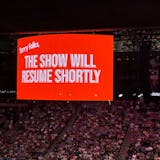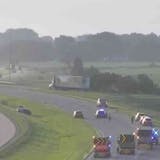Nov. 14, 2015: Jamar Clark, 24, and RayAnn Hayes, 41, attend a party at a north Minneapolis apartment building. Late at night, Clark and Hayes fight. Hayes hurts her ankle.
Nov. 15, 12:20 a.m.: Hayes calls 911 , according to investigative reports. Paramedics arrive and carry Hayes, who is injured and intoxicated, down the stairs and out of the building. They encounter Clark. According to the report, Hayes says, "That's the guy who did this to me." Hearing this, the paramedics call for police backup. Clark approaches the paramedics, berates them, and attempts to enter the ambulance. A paramedic supervisor who is on duty expresses concern about Clark's behavior.
Nov. 15, 12:49 a.m.: Minneapolis police officers Mark Ringgenberg, 30, and Dustin Schwarze, 28, approach Clark. They ask him to remove his hands from his pockets. He refuses. They attempt to handcuff him. Clark resists and Schwarze drops his handcuffs. Ringgenberg takes Clark to the ground. They struggle, and Clark gets his hand on Ringgenberg's gun, though it remains holstered.
Nov. 15, 12:50 a.m.: Schwarze shoots Clark in the head. Protests begin that night with some witnesses claiming Clark was handcuffed when he was shot
Nov. 16: Clark is removed from life support. City officials ask the U.S. Justice Department to investigate the shooting, even as the state Bureau of Criminal Apprehension (BCA) launches its own probe into the incident.
Nov. 17: Protesters march from 4th Precinct to I-94 freeway, blocking traffic and resulting in arrests.
Nov. 18: Authorities identify the two officers involved in the shooting, as Mark Ringgenberg, 30, and Dustin Schwarze, 28, as protesters maintain their round-the-clock presence outside the police station near where Clark was shot.
Nov. 21: Gov. Mark Dayton sits down with Clark's family and asks them to meet with federal investigators.



